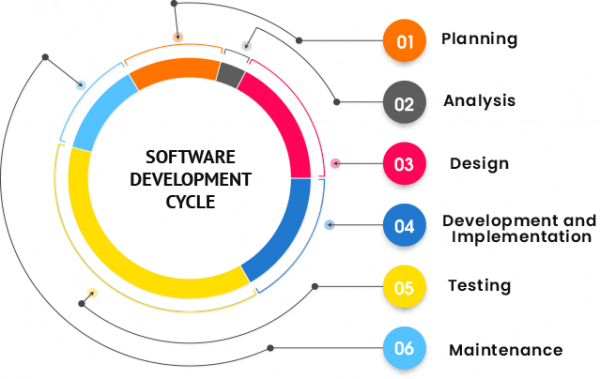Software development and importance of remote teams therein
Every embedded device, including a smart wristwatch or cellphone, looks beautiful for sure because you get to operate and instruct the device with a plethora of inputs. Our beautiful hardware of various categories without any intangible code known as software that runs on it is pretty much worthless. It is only the perfect amalgamation of software and hardware that makes a device what it is. Today, other than pure mechanical devices, it is getting rare to find devices not come with software pre-installed in chips of any hardware you buy rather than on expansion storage options. It won’t be wrong to admit there is always a good set of instructions, also known as software embedded in any hardware you own. One might recognize these instructions as the operating system in most cases with GUI or graphical user interface as it is the layer of the code that you work with on day to day basis. Software is the bridge between the hardware and you to cross the river of knowledge that you need not learn you being just an end-user. So, what is required is a dedicated development team to write software. Software development should work hand-in-hand and parallel with the hardware design and its manufacture. As we need to blend it to make a functional product at the end of the day. The process of software development should be a progressive one with each element assigned to a dedicated development team.
Without going through the individual elements of the whole process of software development, it would not be fair for us to even write about it. It may vary from team to team, but the majority of the teams around the globe accept the following as steps or elements of a successful software development project:
- Studying the requirement
- Design and its implementation
- Development and testing
- Deployment and distribution
- Maintenance and support
Let us take a quick dive into each element.
Studying the requirement is not just one of the elements but one of the most significant ones. First, you visualize and finalize the software requirement for a given project. It is where the top-level project and business managers meet to define the functionality, features, and results of software to be developed. After discussions and careful considerations, it is at this stage itself where you envisage a software. You examine various things, including but not limited to potential users, set of inputs, and desired output. It isn’t a vague sketch of the software but a carefully studied plan which is to be developed after going through all the other elements in the chain. The need to study the requirement is clear and real. You can’t know the most optimal input methods without knowing the age group of the end-users or platform/infrastructure of the company you are deploying the software for. Once you are sure about the project requirement and have devised a formal plan on paper, it is time for you to move to the next element in the chain.
Design and its implementation is where you transform the formal plan from paper to the technical sheet. In other words, we are getting into the marrow of software development now. It isn’t just the GUI’s looks that we are concerned with, but there are other things in design, like picking the programming language for the code, a framework to implement it with ease as per the company’s requirements. Here your formal plan goes through the scrutiny of chief technologist and security analysts. This dedicated team or panel plays a primal role in modern software development today. You can’t just start coding universally even if you might somehow end up with working software, as there is a lot to new in the design sphere. You have to proficiently consider feasibility of the code, data integrity, and optimization in years to come. Once your formal plan has been stamped by proper design and mode of implementation, you can start to code, literally.
Development and testing is a hardcore part of software development. Meet the coders, software developers, who would crank up the mechanical keyboards and music at times, to write the professional code for your software in a swift manner. This is a dedicated development team that works closely to meet the desired goal in time. Their work ranges from writing from scratch to optimizing existing code as per the formal plan’s design guidelines. The whole software development project is divided into various components which are assigned to different software developers or coders or a dedicated team if that specific component requires exponential proficiency. So, various developers work on small components of software on different platforms. Once the software is developed, it is tested among team members in unstable and alpha stages. Here the software produces a lot of bugs or critical issues, mostly fatal in nature. Once these critical bugs are fixed and resolved, a beta product is shared with users identical to the final end-users of the product or at times with real users to get valuable direct feedback. This process of development and testing is a must to produce a stable release. This process of testing takes a lot of years in case of software for masses, and its significance can only be known by the classic case of powerful webmail software called Gmail. It has undergone years of beta testing before finally enter a stable release. Once the software has been developed and tested for the end user’s rock-solid experience, it is time to deliver it.
Traditionally, software deployment or its delivery was simply handing over the code to the clients, and then they copied it on to their systems and ran the code. Slowly computer users moved from business, scientific clients to everyday customers like you and me, and finally, the software industry started packaging software on physical disks or storage options with an easy to use installer for a given operating system. It is called a standalone package or application installer in a retail unit. Long gone are days when you purchase software on a physical disk. The application delivery mechanism has changed. These days most of the applications have a counterpart for embedded devices like smartphones with Application stores on it, for example, with Android, webOS, Tizen, iOS devices. You can’t physically distribute software on these embedded devices owing to restriction of the design itself and at times imposed by the platform as well. So, writing, testing, and distribution software physically might work for the legal part even today, but it doesn’t meet the requirements of end-users today. In today’s software development scene, it is your responsibility to deploy the software digitally among various application stores too properly. It, in a way, helps you and makes it easy for the distributor to release upgrades and reach out to the end-users for any critical issues or convey vital information, if any. On open platforms like Android, GNU/Linux, you get to develop your own application delivery distribution mechanism or just deploy your own private/secure repositories for that given platform. It is starting to see how the app delivery has changed over time. The need of the hour is secure, swift delivery using multiple channels other than traditional delivery of the software using digital access links.
There is more to software development than the final distribution of the software. The world is an ever-changing place. So, is the requirements. Hence there is a need to make changes in the software every now and then. Also, no matter how well-written software is, one can’t imagine to use it without a proper manual, documentation, and support. In a nutshell, maintenance and support are the final link in the chain or the complete process of software development. Every smart buyer or consumer goes for the best after-sales support. A well-documented software with great human support from a small company is preferred over software from a big corporation with automated support bots in many cases. Usually, maintenance is where most of the software, including the once from big banks, lag at times. A dedicated team of software development must remind their clients about this and make sure they make it the inclusive part of the deal even if the end-user support is completely outsourced. When you timely maintain software, you keep the vibe of the core software technology and its integrity intact.
As read above, there are no codified principles yet universally accepted elements of the process of software development around the globe. Also, how an envisioned software is finally delivered using advanced app delivery mechanisms from a well thought and devised a formal plan from technical design guidelines to documentation. It has gotten so sophisticated. Hence you divide it into various components assigned to a dedicated development team that works on it to overthrow any challenges as it comes in the course of software development.
There is another dimension that we need to discuss these dedicated development teams. Internet technology has entered everything and anything. People access information worldwide using the Internet. So can developers. With secure communication tools, developers get to work remotely. Originally, remote work was done by full-time employees from outside offices, for example, from vacation for an emergency or from home during a casual leave. It is still one of the popular segments of the remote work as we know. That being so, there exist companies with actually remote employees, hired to work on software remotely. With use of robust and secure virtual access technologies, you can allow access to particular array of your code for remote teams with expertise on the specific field. Some of the software development companies exists that function under this remote model allowing and entertaining talent from world-wide expunging the dated, stale traditional model of on-site development. It just makes no sense in 21st century or in the new world of startups and freelancing to hire people and in a way force them to do the work your way and monitor their other activities than the software or code that they deploy of the component that they are working on. It is too much for too many. It increases overall administration cost and hence is slowly being moved to the newer remote model of development. Remote teams have always been popular in the last link of the process of software development i.e. maintenance and support. End user support has always been outsourced to a dedicated remote team who specialises in this realm.
One should not treat remote teams as second class developers. They are as real as on-site developers. A developer from Philippines working for a Nordic data storage company remotely is no less than a local full-time on-site developer. Remote teams are nifty and viable options that are being hired with the same level of importance as others. After all, we aim to eradicate the differences that man-made physical boundaries have drawn and connect hearts with Internet technology and professional software development.
















